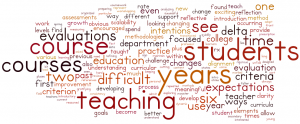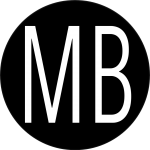 Included in this section is a reflective piece that I developed at two year intervals (year two, four, and year six) as a part of the tenure and promotion process. The posted reflection is from my sixth-year evaluation. Using the text from this document, I used Wordle to create a “word cloud”. The resulting image below is a linguistic map that shows the relative frequency of the words I used throughout my reflection, but it also illustrates my reflective work and places concepts and ideas in new and creative locations in hopes of generating new thoughts and associations.
Included in this section is a reflective piece that I developed at two year intervals (year two, four, and year six) as a part of the tenure and promotion process. The posted reflection is from my sixth-year evaluation. Using the text from this document, I used Wordle to create a “word cloud”. The resulting image below is a linguistic map that shows the relative frequency of the words I used throughout my reflection, but it also illustrates my reflective work and places concepts and ideas in new and creative locations in hopes of generating new thoughts and associations.
For each of the criteria for evaluation, I refrained from providing long lists that support each criterion. I have chosen to let the included vitae, course evaluations, and observations speak for themselves regarding my activities, and spend time reflecting on my current status for each criteria and provide a direction for how I see each criteria evolving in the future. More specifically, I intend to use the Plus-Delta-Rx method for reflection. This is the reflective process I asked my students to use when analyzing their own teaching practice. In this method, “plus” represents the elements of each criterion that I have found to be successful over the past six years. “Delta” will represent the elements within each criterion that are in need of some sort of change. For each “delta” provided I will also provide an “Rx”, or a prescription as to how each delta could be improved.
Plus. Looking at the four criteria, teaching has always been one of my consistent pluses. Over the past six years I have seen continual growth and improvement in my course evaluations. I will admit that this has been a bit surprising given the fact that in six years I have taught, and in some cases designed, 17 different courses for my department and the College. With such a range of courses, and little opportunity to perfect them at times, it is exciting to see my evaluations not falter, but improve in focused and intentioned ways.
Previous review cycles have helped me target aspects of my teaching practice for improvement and encouraged me to work in measured steps to see that these changes have an impact. In particular, I focused on issues related to clarity of expectations, scalability of expectations for various levels of courses, and a more obvious alignment of assessments and curricular goals. It is a difficult balance to strike when measuring student evaluation data against one’s own personal philosophy and course intentions. There are times when a teacher wants a student to be frustrated or challenged. Developing learning experiences where that challenge and frustration is meaningful is difficult, but even more difficult is helping students to understand how these situations develop them as learners. Over the past six years I have been able to find a much better formula for mixing challenge and purpose and delivering those intentions to my students in a way that they too see as meaningful.
My course evaluations for 2011 – 2012 underscore how far I have come as a college professor. I intentionally focused my evaluation summaries on First Year Seminar in the fall and my Introduction to Education course in the spring. One course worked with incoming first years, and the second course was a large intro level experience – two difficult teaching populations. While there were references to clarity of expectations, scalability of expectations for various levels of courses, and a more obvious alignment of assessments and curricular goals, students had a much better understanding of my intentions and saw value in methods – even if they were hard or difficult. Through the use of repeated reflection and analysis from my previous reviews, the methodologies I employed during those two semesters resulted in fantastic evaluations from my students. While my work at refining my teaching practice will never be complete, it has been gratifying to live out the reflective process I encourage my students to use and to see the success unfold in front of me.
Delta and Rx. The types of environments I am preparing our students to teach in are changing at an incredible rate. On one hand, this makes my job very dynamic and exciting. On the other, it can become quite intimidating and disorienting. In the last couple of years I have found myself wanting more time to develop new and cutting edge curricula to prepare our students for the changes in the field that we already see. A great example of how quickly the landscape is changing lies within my Introduction to Adolescent and Young Adult Education course. I taught this course during my first three years at the College of Wooster. I then transitioned to support the department in teaching the introductory courses for two years. Now in my sixth year, I am back to teaching the courses for students interested in secondary education. While I was only away for two years, the way high schools are organized and the manner in which content is being delivered is radically different. States have adopted national curricula, and teachers are being encouraged to adopt technological enhancements to their teaching that were not even being considered two years ago. I find this to be an especially intriguing time to be in teacher education, but the rate at which change is occurring requires one to devote more and more time to understanding the transformations and developing ways for our students to become effective in these new reforms.
Looking beyond year six, I hope to maintain some consistency in the coursework I teach. This will allow me to be more intentional in my own growth and development as a teacher, and to spend more time workshopping ideas and methodologies for courses over multiple iterations. I am also excited to scaffold the curriculum throughout all of my courses in ways that will allow me to be flexible and reasoned when exploring and teaching about the changes that are occurring – keeping our department and programs relevant, rigorous, and responsive.
